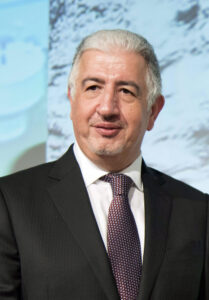
Central Asia’s economic promise is growing. With foreign investors taking note, this could unlock the potential of small and medium enterprises (SMEs) in the region. However, there are certain systemic issues that remain a major stumbling block.
Let’s not underestimate the critical role SMEs play in the economic development of Central Asian countries. In 2023, SMEs in Kazakhstan contributed 33.7% to their GDP and 54.
5% in Uzbekistan. However, SMEs in Central Asia often face a challenging task of securing the necessary capital to expand their business. Eng.
Hani Salem Sonbol. Photo credit: itfc The World Bank states that access to finance for SMEs is the second most cited obstacle in emerging markets and developing countries, while SMEs play a crucial role in creating seven out of 10 jobs. An example of this is the loan approval process.
SMEs often find the process tedious and complex, which mostly ends in the rejection of an application. Also, SMEs face high lending rates which deters businesses from sourcing additional funding and hampering their growth capabilities. As a result, many SMEs rely on internal funds, or cash from friends and family, to launch and run their businesses.
The International Finance Corporation (IFC) estimates that the formal micro, small and medium enterprises (MSME) finance gap now stands at $5.7 trillion worldwide – a number that swells to $8 trillion when informal enterprises are included. But without SMEs, like in any other economies, the countries of Central Asia will face challenges in meeting their economic objectives and development aspirations.
So how can the International Islamic Trade Finance Corporation (ITFC) support SMEs in securing access to finance and finding innovative solutions to unlock sources of capital through sustainable means – thus contributing to the region’s economic growth? First, let me introduce you to Islamic finance. Fundamentally it is a financial system that follows Shariah (Islamic) law and forbids interest, encourages risk-sharing and only allows ethical investments with all transactions obliged to be asset-backed. It is implemented to balance religious principles with economic activities.
A subset of Islamic finance is Islamic trade finance which focuses, specifically, on financing short term trade transactions. It is quickly becoming a more prominent and influential avenue to help combat fundamental economic and transactional issues. A key Islamic trade finance instrument is Murabaha.
A Murabaha agreement is when the seller and buyer agree on the cost and mark-up of an asset. This enables businesses to buy products/commodities at a deferred price with the cost and profit margin pre-agreed. This financial structure allows for better forecasting, enabling businesses to plan their operations more accurately.
An example of this type of financing is the $300 million Murabaha financing between ITFC and Uzbekistan. This financing contributes to food security and agricultural sustainability through the procurement of strategic agricultural commodities and ensures a stable supply of wheat in the country throughout the year. But how would Islamic trade finance directly benefit SMEs? Since ITFC began offering financing facilities in Central Asia, they have allocated around $2 billion in the region.
From this amount, ITFC has approved financing to support the private sector and SMEs in Uzbekistan ($530 million), Kazakhstan ($810 million), Turkmenistan ($25 million) and Kyrgyzstan ($23 million) with the full financing amount totalling $1.38 billion. In addition to creating alternative financing channels, these facilities also targeted women-led SMEs and promoted green financing among small enterprises, boosting SMEs contribution to the country’s economic development.
Within the scope of the Framework Agreement between Uzbekistan and ITFC, covering the 2024-2026 period, ITFC will also focus on expanding the Islamic trade finance support of SMEs, where emphasis will be given to ESG-compliant financing solutions. Based on our success in Uzbekistan, there are plans to expand the trade finance solution offering across Central Asia. For instance, in Kyrgyzstan, ITFC is partnering with microfinance institutions to meet the need for Islamic finance among the MSMEs in this country.
In Tajikistan, we are working to establish partnerships with leading local banks to provide Islamic trade finance solutions to MSMEs. Similarly, in Azerbaijan and Kazakhstan, opportunities are being explored in offering both financing in the form of both funded and non-funded interventions to enable the SMEs to benefit from cross-border trade. As part of this expansion plan, ITFC will expand its trade development services to SMEs in Azerbaijan and Central Asia in 2025, alongside its recently launched Trade Connect Central Asia+ (TCCA+) Program, which facilitates economic growth and regional economic integration amongst the six Organisation of Islamic Cooperation (OIC) member countries in the Central Asia region.
So, when we talk about trying to find solutions for SMEs and aligning that with the overarching goal of economic growth across Central Asia, Islamic trade finance provides the necessary fundamentals to ensuring the financing structures are more resilient, sustainable and achievable. With the instrument already becoming more popular across the region, it is just a matter of time before all member countries are reaping the benefits. The author is Eng.
Hani Salem Sonbol, the CEO of the International Islamic Trade Finance Corporation..












